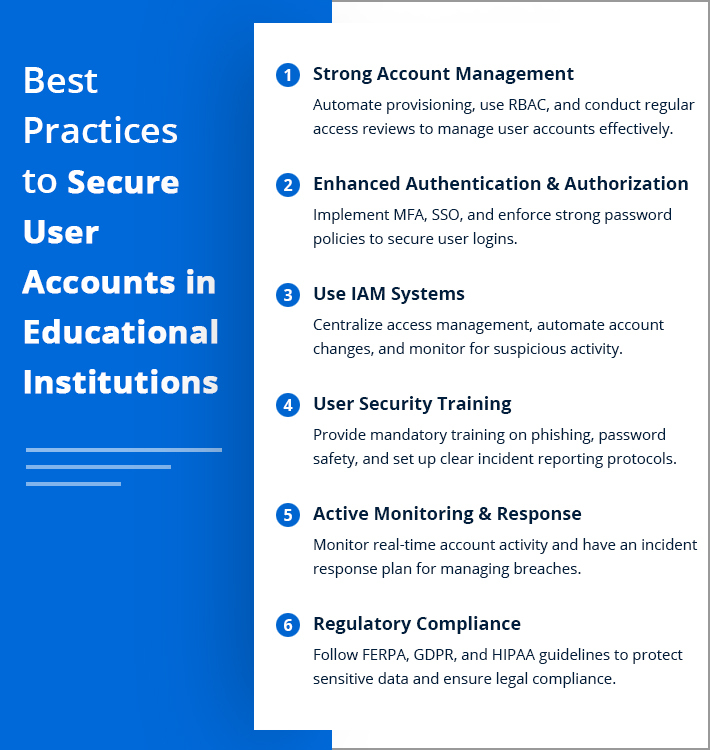
Managing user accounts securely in higher education is a complex and critical task. Universities and colleges handle sensitive data for a wide variety of users including students, faculty, staff, and alumni, each with unique access requirements. With the surge in cyberattacks targeting educational institutions, the stakes for effective account management have never been higher. Institutions must adopt security measures that are not only robust but also flexible enough to adapt to the constantly evolving user base.
This in-depth guide explores the best strategies, practices, and technologies to ensure the secure management of user accounts in higher education.
Common Challenges of User Account Management in Higher Education
Educational institutions differ from typical organizations when it comes to managing user accounts. Here are some key challenges:
- Dynamic User Base: Universities experience high user turnover with students graduating, faculty moving between departments, and temporary staff. This constant flux demands efficient onboarding and offboarding of user accounts.
- Multiple Roles and Access Levels: Unlike in a corporate environment, a single user in higher education might hold multiple roles—such as a faculty member who is also a student or a researcher with administrative duties. Managing these varied access levels securely is complex.
- Cybersecurity Threats: Universities are prime targets for cyberattacks, from phishing to ransomware. A lack of proper security controls can lead to breaches that compromise sensitive research, personal information, or intellectual property.
- Compliance with Data Protection Regulations: Institutions must adhere to strict data protection regulations like FERPA (Family Educational Rights and Privacy Act), GDPR (General Data Protection Regulation), and HIPAA (Health Insurance Portability and Accountability Act) when handling sensitive student data.
How to Secure User Accounts in Higher Education

Build a Strong User Account Management Policy
The foundation of secure account management is a well-defined, clear, and enforceable user account management policy. Here’s what should be included:
Account Lifecycle Management
Every account should be properly managed throughout its lifecycle, from creation to deletion.
- Onboarding and Provisioning: Develop strict identity verification processes before creating an account. For instance, ensure that students can only access academic resources and administrators have permissions limited to their job roles.
- Role-Based Access Control (RBAC): RBAC simplifies access management by assigning predefined access permissions based on the user’s role. For example, professors might have access to research databases and course management tools, while students only have access to academic portals.
- Automated Provisioning and De-Provisioning: Automating this process can prevent delays in account creation and eliminate the risks associated with lingering, orphaned accounts when someone leaves the institution.
Regular Audits and Access Reviews
Accounts and access rights must be periodically reviewed to ensure they remain appropriate.
- Routine Access Reviews: Review account access based on current roles and responsibilities. Adjust permissions for students who switch majors or faculty members who take on administrative roles.
- Automated Auditing Tools: Leverage tools that flag unused accounts, mismatched permissions, or unauthorized access attempts. This keeps administrators aware of potential vulnerabilities.
User Roles and Permissions
Managing permissions can be tricky with thousands of users, but it’s essential to follow the principle of least privilege.
- Principle of Least Privilege (PoLP): Limit user access rights to only what is necessary for their role. For instance, a student worker in the IT department should not have access to sensitive HR or financial data.
- Segregation of Duties: For users with multiple roles, segregate permissions so they can’t abuse access. For example, a user who can authorize expenses shouldn’t also be able to approve them.
Offboarding Procedures
Timely offboarding is critical to prevent former users from maintaining access to the institution’s network.
- Automated De-Provisioning: Ensure that accounts are automatically deactivated when a user leaves the institution. Set a grace period for transitioning, after which the account is permanently deleted or archived.
- Data Retention Policies: Establish clear guidelines for how long data associated with an account (such as emails or research files) is retained before it is deleted or archived.
Implement Strong Authentication and Authorization Protocols
Strong authentication mechanisms are essential for securing user accounts in higher education, where users often access systems from multiple devices and locations.
Multi-Factor Authentication (MFA)
MFA adds an extra layer of security by requiring two or more verification methods.
- Why MFA is Essential: A password alone is no longer enough to secure sensitive data. MFA drastically reduces the chances of unauthorized access. For example, a student’s account could be compromised if they reuse passwords across different platforms, but MFA will block access without the second form of verification (such as a code sent to their phone).
- MFA Implementation Tips: Offer multiple methods of authentication (e.g., mobile apps, biometrics, email) to make the process user-friendly. For remote access to sensitive systems, require stronger MFA methods like biometrics.
Single Sign-On (SSO)
SSO simplifies the login process by allowing users to access multiple applications with a single set of credentials.
- Benefits of SSO: SSO reduces password fatigue, lowers IT support requests, and increases security by centralizing authentication management. For example, a professor can log in once and access their email, learning management systems, and research portals seamlessly.
- Integrating SSO: Ensure your SSO solution integrates with cloud-based applications, internal databases, and third-party services used by the university.
Password Policies
While MFA is effective, enforcing strong password policies remains crucial.
- Enforcing Complex Passwords: Require complex passwords (e.g., a mix of letters, numbers, and special characters) that are difficult to guess. Encourage the use of password managers to make compliance easier.
- Regular Password Rotation: Set policies that require users to change their passwords regularly, but avoid forcing too frequent changes that could lead to weaker password choices.
Leverage Identity and Access Management (IAM) Systems
IAM solutions are designed to centralize and automate the management of user identities and access permissions.
Key Benefits of IAM for Higher Education
- Centralized Access Management: IAM systems provide a single platform to manage user credentials, permissions, and roles across the institution. This centralization helps eliminate inconsistencies and allows IT teams to have a real-time overview of user access.
- Automated Provisioning and De-Provisioning: IAM systems automate user provisioning and de-provisioning based on lifecycle events such as student enrollments, graduations, or employee retirements.
- Enhanced Security with Continuous Monitoring: IAM solutions offer continuous monitoring and auditing of user accounts, flagging anomalies in access patterns or changes in account permissions.
Integration with Directory Services
For higher education institutions using directory services like Active Directory or LDAP, integrating IAM with these systems is critical. It helps synchronize user accounts across multiple platforms and ensures that any changes in user status are reflected throughout the system.
Educate and Empower Users
No matter how secure the technology, the human element remains a critical vulnerability. Developing a culture of security awareness is essential for protecting user accounts.
Security Awareness Training
Provide mandatory security training for all users, especially incoming students and new employees. Topics should include:
- Phishing Awareness: Educate users on recognizing and avoiding phishing attempts, which are a common attack vector in higher education.
- Best Practices for Password Management: Offer guidance on creating strong passwords and using password managers to reduce password reuse.
- Safe Internet Browsing: Instruct users on safe online practices, such as avoiding suspicious downloads and securing their devices.
Incident Reporting Protocols
Create clear protocols for users to report suspicious activity. For example, if a user notices an unusual login or suspects their account has been compromised, they should know how to quickly alert the IT department.
Ensure Proper Monitoring and Incident Response
Proactive monitoring and a well-defined incident response plan are crucial for mitigating risks and responding to breaches.
Continuous Monitoring
Implement real-time monitoring tools that track user account activities. Look for anomalies such as:
- Unusual login times or from unexpected locations
- Multiple failed login attempts
- Access to resources outside the user’s normal permissions
Incident Response Plan
Develop a robust incident response plan that includes:
- Roles and Responsibilities: Assign specific duties to staff members in the event of a security breach.
- Breach Containment: Outline steps for containing breaches, such as temporarily suspending compromised accounts and restricting access to sensitive data.
- Communication Protocols: Ensure that affected users are promptly informed of any breach and provide guidance on steps they can take to secure their accounts.
Download Whitepaper

Regulatory Compliance and Legal Considerations
In the context of higher education, compliance with data protection regulations is non-negotiable. Institutions must adhere to both local and international laws.
FERPA (Family Educational Rights and Privacy Act)
FERPA protects the privacy of student education records. Ensure that only authorized personnel can access student data and implement strict auditing procedures to monitor access.
GDPR (General Data Protection Regulation)
For institutions that deal with EU-based students or staff, GDPR compliance is essential. Ensure that personal data is processed securely, and that users have control over how their data is used.
HIPAA (Health Insurance Portability and Accountability Act)
If your institution handles medical records or healthcare data, HIPAA compliance is required. This involves securing not only user accounts but also medical information related to students and staff.
How Lepide Can Help
Lepide Data Security Platform offers comprehensive solutions for managing user accounts and securing sensitive data in higher education institutions. With features like:
Active Directory Auditing: Track user activities and detect unauthorized access to ensure account security.
User Behavior Analytics: Monitor user behavior to detect unusual activity and potential security threats.
Conclusion
Managing user accounts securely in higher education requires a multifaceted approach that combines technology, policy, and education. As technology advances and cybersecurity threats grow more sophisticated, higher education institutions must continuously adapt their strategies for managing user accounts. Furthermore, fostering a culture of awareness and ensuring compliance with ever-changing regulations will not only secure institutional data but also build trust among students, faculty, and staff. Ultimately, investing in these strategies is crucial for future-proofing user account management, ensuring a secure, efficient, and resilient environment in the digital era of education.
If you want to know more about how Lepide can help, schedule a demo with one of our engineers today.



